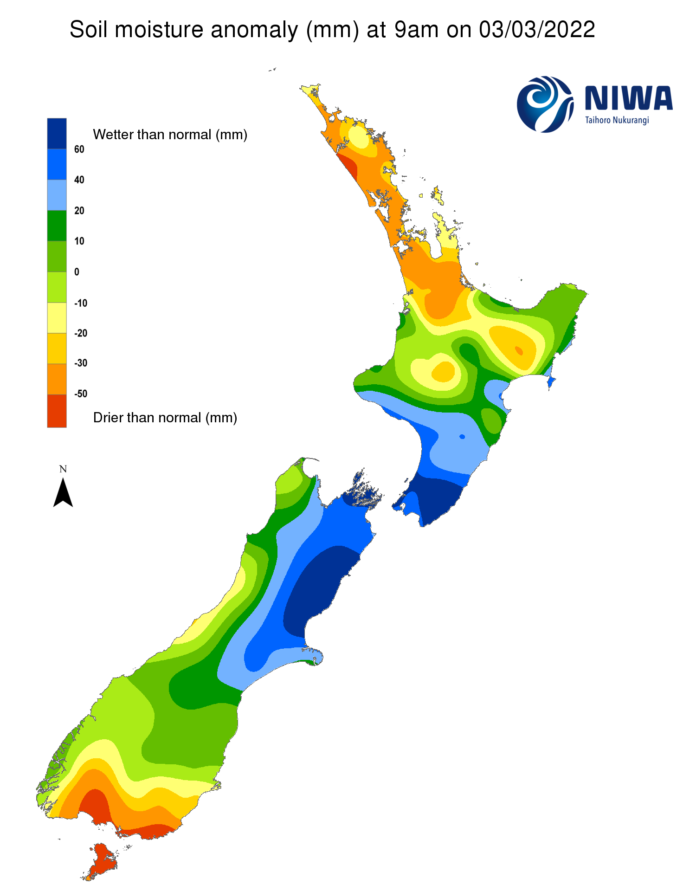Source: NIWA – National Institute of Water and Atmospheric Research
A weekly update describing soil moisture patterns across the country to show where dry to extremely dry conditions are occurring or imminent. Regions experiencing significant soil moisture deficits are deemed “hotspots”. Persistent hotspot regions have the potential to develop into drought.
Facts: soil moisture
In the North Island, it was a mostly dry week. Although isolated pockets of northern Hawke’s Bay collected 10-25 mm, elsewhere received generally less than 10 mm. This resulted in soil moisture decreases across the North Island. The driest soils across the North Island, when compared to normal for this time of the year, are found in western Northland, while the wettest soils for this time of the year are found in Wellington.
Due to the last week’s dryness, hotspots have expanded to encompass western Northland, Auckland, and central and northern Waikato. As of 2 March, the New Zealand Drought Index (NZDI) map below shows that dry or very dry conditions are now located across much western Northland, Auckland, and northwest Waikato.
In the South Island, 5-10 mm was observed over the last week over much of the island. However, some areas in west like Westport saw isolated weekly totals near 50 mm. Despite these larger isolated rainfall totals, this resulted in soil moisture decreases across much of the South Island. The driest soils in the South Island, when compared to normal for this time of the year, are located in coastal Southland, Rakiura/Stewart Island, and the Clutha region, while the wettest soils for this time of the year are found from northern Canterbury to the Marlborough Sounds.
Hotspots remain in place across much of coastal Southland, northern Stewart Island and the coastal Clutha region. As of 2 March, the New Zealand Drought Index (NZDI) map below shows that dry or very dry conditions in and Southland, with pockets of dry conditions along the Clutha coast. In addition, extremely dry conditions are located in southern parts of Southland and Rakiura/Stewart Island.
Outlook and soil moisture
In the North Island, high pressure will continue to dominate during the next week. Light and isolated coastal showers will feature nearly daily across parts of Northland, Auckland, the Coromandel, Bay of Plenty and northeast Gisborne, but it looks largely dry elsewhere. A weak southerly change will bring the chance of a few light showers to coastal Wellington and Hawke’s Bay on Sunday and Monday. Many areas, particularly those in central and western districts, look to have a completely dry week.
Due to the lack of rainfall expected in the next week, soil moisture levels are likely to decrease nearly everywhere in the North Island. This will likely result in a further expansion of the current hotspots located in the upper North Island, and the perhaps even the emergence of new ones in central and eastern areas.
In the South Island, a front will move north on Sunday (6 March). This feature will draw down an atmospheric river across Fiordland, bringing a period of persistent rainfall. 72-hour rainfall totals from Sunday to Tuesday could exceed 150 mm. However, the remainder of the South Island looks mostly dry during this period, aside from isolated showers for western areas. Late next week, there is the chance of widespread rain and showers across the west coast.
Due to the expected rainfall in the next week, soil moisture levels will likely decrease across the majority of the South Island, except for parts of Southland. This will likely cause current hotspots in Southland and Clutha to remain the same or expand slightly.
Background
Hotspot Watch: a weekly advisory service for New Zealand media. It provides soil moisture and precipitation measurements around the country to help assess whether extremely dry conditions are imminent.
Soil moisture deficit: the amount of water needed to bring the soil moisture content back to field capacity, which is the maximum amount of water the soil can hold.
Soil moisture anomaly: the difference between the historical normal soil moisture deficit (or surplus) for a given time of year and actual soil moisture deficits.
Definitions: “Extremely” and “severely” dry soils are based on a combination of the current soil moisture status and the difference from normal soil moisture (see soil moisture maps).
Hotspot: A hotspot is declared if soils are “severely drier than normal” which occurs when Soil Moisture Deficit (SMD) is less than -110 mm AND the Soil Moisture Anomaly is less than -20 mm.
]” title=””>
]” title=””>
Pictured above: Soil Moisture Anomaly Maps, relative to this time of year. The maps show soil moisture anomaly for the past two weeks.
As of 2 March, the New Zealand Drought Index (NZDI) map below shows that dry or very dry conditions are now located across much of western Northland, Auckland, northwest Waikato, Southland and the pockets of the coastal fringe of Clutha. In addition, extremely dry conditions are located in parts of Southland and Stewart Island. Please note: some hotspots in the text above may not correspond with the NZDI map. This difference exists because the NZDI uses additional dryness indices, including one which integrates the rainfall deficit over the past 60 days. Changes are therefore slower to appear in the NZDI compared to soil moisture anomaly maps that are instantaneously updated.
]” title=””>



